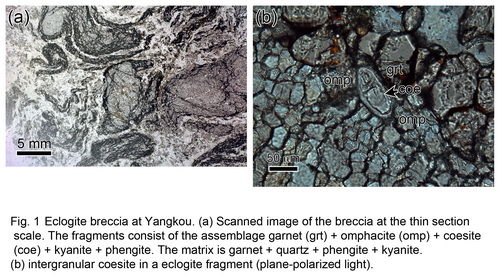Coseismic Ultrahigh-Pressure MetamorphismUpdate time:09 16, 2014
Eclogite breccias are formed by earthquakes in high-pressure metamorphic belts. Coesite is the high-pressure form of quartz. The coesite-bearing eclogite breccia found recently by Yang et al. from the Institute of Geology and Geophysics, CAS, at Yangkou in the Chinese Su-Lu ultrahigh-pressure metamorphic (UHP) belt is, thus far, the highest pressure record of earthquakes. According to popular current theory, coesite-bearing eclogites were subducted to and exhumed from >90 km below the Earth’s surface. Given that coesite converts completely to quartz in a few years in the presence of only minor amount of water when being decompressed and cooled slowly from UHP conditions, previous workers suggested that intergranular coesite can only be preserved under absolutely dry condition during exhumation from a great depth. In this case, the coesite-bearing eclogite breccia at Yangkou can be regarded as the deepest known earthquake hypocenter in a subducted slab now exposed on the surface. In their work, however, Yang et al. (2014) realized that intergranular coesite occurs only in the fragments, not in the matrix, of the Yangkou eclogite breccia (Fig. 1). The matrix contains about 20 % of phengite (a high-pressure mica), which locally melted and released water during the earthquake and rapidly crystallized into the assemblage K-feldspar + quartz + albite. This shows that the rock was not dry during the high-pressure event. The fragments themselves also contain minor amounts of phengite. Moreover, the released water in the matrix can diffuse into the fragments in a few hours under UHP conditions. Therefore, the eclogite breccia cannot be kept absolutely dry during the subduction/exhumation processes, which last for millions of years. Calculation shows that, in the presence of fluid water, the preservation of intergranular coesite and the crystallization of the low-pressure mineral albite from earthquake generated melt are possible only when the rock is cooled rapidly from the UHP conditions to the normal temperature of the crust (<400 °C, Fig. 2). These indicate that the eclogite breccia and intergranular coesite therein record a transient (coseismic) UHP event and cannot be taken to be deeply subducted materials.
Reference Yang, J.-J., Huang, M.-X., Wu, Q.-Y., and Zhang, H.-R., 2014, Coesite-bearing eclogite breccia: implication for coseismic ultrahigh-pressure metamorphism and the rate of the process. Contributions to Mineralogy and Petrology, 167:1013-1030.
|
Contact
Related Articles
Reference
|
-
SIMSSecondary Ion Mass Spectrometer Laboratory
-
MC-ICPMSMultiple-collector ICPMS Laboratory
-
EM & TEMElectron Microprobe and Transmission Electron Microscope Laboratory
-
SISolid Isotope Laboratory
-
StIStable Isotope Laboratory
-
RMPARock-Mineral Preparation and Analysis
-
AAH40Ar/39Ar & (U-Th)/He Laboratory
-
EMLElectron Microscopy Laboratory
-
USCLUranium Series Chronology Laboratory
-
SASeismic Array Laboratory
-
SEELaboratory of Space Environment Exploration Laboratory
-
PGPaleomagnetism and Geochronology Laboratory
-
BioMNSFrance-China Bio-mineralization and Nano-structure Laboratory

 Print
Print Close
Close

